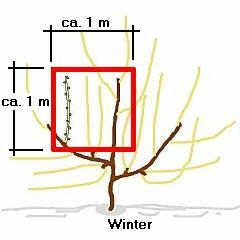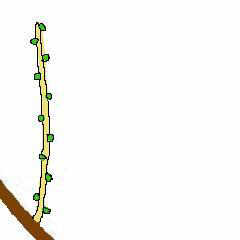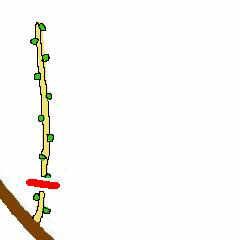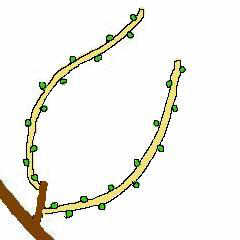Cane Pruning
Cane Pruning ('long' pruning) - also known as "arched cane pruning" or the Guyot Method - with 8-12 eyes on the canes, is commonly used in vineyards and occasionally used on grapevines grown along house façades. With this method, vigorous grapevine varieties can be 'tamed,' gaps in the main framework bridged, and very high fruit yields achieved. Here we illustrate this technique for fully trained vines. Please also refer to the information under Training in the 1st to 3rd years!
The diagrams below illustrate the pruning technique over several years based on a single "side shoot" arising from the stem. Other side shoot positions have already been established on the stem framework, usually about 40-80 cm apart, which may be spur or rod pruned. The new side shoot position shown in the following diagrams is developed from one shoot, which was well-planned during the vine training. When rejuvenating an older vine, the same procedure can be applied to a water shoot which has arisen from the main trunk, to form a new side shoot.
Cane pruning is divided into 3 steps: pre-pruning, fruit cane pruning, and bending/tying. These steps can be carried out immediately one after the other or in stages over a few days or weeks. For vines growing along the house, we recommend the following: all side shoot positions (branches) of the vine are first pruned so that the bulk of the wood is removed and the vine becomes manageable. This also facilitates the pruning of the fruit canes and counting of the 10-20 buds per square metre of wall space.
The diagrams in the column to the left show the side shoot after leaf fall in winter, and the pre-pruning into the old wood (dark brown). The vine was pruned in summer; otherwise, the shoots would be much longer now. Each cane produced an average of 1-2 grape bunches in summer. The diagrams in the centre illustrate the fruit cane pruning into previous year's wood (ochre), and the diagrams on the right side show the results. The additional required bending/tying is described separately.

Diagram 07: (refer also to Image 01 above.) All shoots of the arched cane ideally produced 1-2 grape bunches in summer and are now worn out. In the pre-pruning, the entire arched cane with all its shoots is removed. Often the two shoots growing from the replacement spur are so vigorous that they can keep the fruit produced in summer; otherwise, the grapes will have been removed at the beginning of summer.
















